#(( i know. i need to get new yui sprites :
Note
(I’m pretty nervous about this but i’ll try my best)
How would Yui react when someone who is pretty much the same species as the Sakamaki be overly protective of her?
Yui: ( What's going on? This person is... protecting me? Maybe I judged Vampires, as a whole, a little too harshly...? )

Yui: It's nice to know someone is looking out for me... Thank you.

#(( i know. i need to get new yui sprites :/#diabolik lovers#dialovers collection#the-most-diabolik-of-lovers#ask#react#yui komori#komori yui#diabolik lover x reader#dialovers#diabolik lovers ask blog#anonymous
92 notes
·
View notes
Text
Hey everyone! Feel Less will be going on a short hiatus... but we're not going anywhere!
Allow me to explain~
So, I gave a similar explanation last time, but because I'll be introducing some new characters, I need some time to finish all the art. I thought I could do it last week, but the extra week I took only allowed me enough time to finish Anna's sprites and cutscene graphics from the latest update, which I hope you enjoyed~ but I have to be honest with myself, and admit that in order to finish everything I want I need to take way longer than just 1 extra week.
You see, things in Feel Less are about to get fuuuuuuuuuucked up real interesting! [REDACTED] isn't the only character that's getting introduced you know~ The Some Things Are Better Left Unknown story route includes at least 3 other characters that could potentially join the party! And they're not gonna draw themselves lmao. Besides the new characters, there's also some very important story beats that are coming, which will also require original art. I could of course do everything with the sprites and backgrounds, but that'd be sacrificing some of the quality of the comic, and I don't want the story to suffer just to get it out on a self-imposed deadline, you know? This is not to mention the backgrounds needed for the new locations so... yikes! This is definitely gonna take longer than a week! Especially because I have a job besides posting comics online (sadly, I wish I could just do this full time aslkdmakldmml 😭)
Another important thing to note is that we'll be disabling player interaction for a bit, at least until all the important story points have been covered, which I think should be the next 3 updates.
Now, what do I mean by "we're not going anywhere"? Well, because this blog won't be going radio silent until everything's done, like I used to do in the past! I'll be streaming most of my art process on my twitch channel! I usually play games on there, but I'm going on an Art Stream Marathon until all the art for Feel Less has been completed! (I really, really want to prioritize this. Neon White can wait.) For those of you who don't know, I stream every Thursday and Saturday from 2:30 pm EST, to around 5:30pm. I'll be posting links to the streams on this blog every day I do them, so come say hi! 💖 There will be slight spoilers for character designs, but not plot points, so dw~
I want to close by saying that, to be completely honest, I never enjoy putting my works on hiatus. Keeping momentum going on a webcomic is difficult, but I have to make sure Feel Less is 100% something I can be proud of and not a rushed product. There's some cool stuff coming, and I want it to have the impact it deserves.
As always, thank you all so much for your support! The fact that you guys take the time to read my webcomic makes me so happy~~ 🥰 Also, important to mention that while the story's on hiatus the inbox will be wide open! So feel free to send questions and stuff, I'll still be here~ See you all soon!!!
-Yui Wrong 💖
26 notes
·
View notes
Text
A look at: Moon.
Writing reviews is always a learning experience for me, and one of the important things I’ve learned is that, sometimes, it’s pretty hard to write about certain individual games, visual novels, or such considering the kind of detail I like to go into. Therefore, this will be the first in a new series of mini reviews, or as mini as they get with me. Maybe there’s just not enough to a game to really give me details to dig into, or maybe it’s difficult to talk about without giving away more than I wish, or maybe there’s just something related to it that I’m more interested in talking about than the actual product; whatever the reason, these will hopefully be less rambly and excessive than my usual reviews, while still giving enough of an overview that they stand as proper reviews on their own. Either way, the subject of this post is an old, obscure visual novel from 1997 with a bit of history to it, called Moon.

Moon was developed by Tactics, a humble developer of adult visual novels, and was the second one developed by them, with the first, Dōsei, seemingly just being, well, a plain H-game, and the third, One ~To the Radiant Season~, while still obscure, is actually fairly notable for being a prototype to Kanon in a lot of ways, as many key staff at Tactics would later break off to form Key afterwards, with them having also worked on Moon beforehand. Thus, Moon is in a very interesting spot when it comes to the progression of the developers that would change VNs as a genre with the release of Kanon, and that’s really the only reason I checked it out.
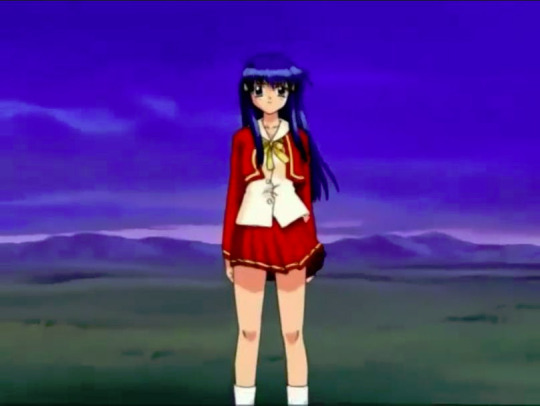
Moon follows Ikumi Amasawa, a girl who joins a mysterious organization called Fargo, which recruits others with the promise of acquiring an alleged “invisible strength” that can put one far ahead of ordinary humans, in order to investigate their possible connections to the murder of her mother, and if possible, take revenge on the ones responsible. Upon arriving at the Fargo facility, Ikumi quickly befriends two other initiates with ulterior motives of their own for joining: Haruka Mima, a determined girl with a cool attitude who keeps her goal to herself, and Yui Nakura, a cheerful, but naive girl who’s seeking to bring home her older sister, who joined Fargo several months prior. Though the three agree to become allies and help each other achieve their goals, they are quickly separated in different “classes” housed in different buildings, with Ikumi being assigned to Class A, the most prestigious of them all. Settling into her new life as a Fargo initiate, which mostly consists of “training” with the Minmes and Elpod, machines that confront her with various parts of her very troubled past for the purpose of “mental reinforcement” in the form of a vengeful doppelganger of herself, Ikumi gradually discovers many strange things about her situation, such as there only being one other member of Class A, that being Youko Kanuma, a quiet, cold woman who has been part of Fargo for many years. Additionally, Ikumi is forced to share her room with a strange boy who doesn’t volunteer his name, who, though part of Fargo itself, is quite low ranking, and more than a bit dim witted at times. Worst of all, upon finding a passage that allows her to access the buildings where her allies are kept, Ikumi finds that the other classes are subjected to horrific abuses by Fargo’s personnel in order to further their mental reinforcement. As Ikumi struggles to aid her allies however she can, the confrontations with her past begin to put a heavy strain on her mind, and the existence of the invisible strength Fargo claims to have starts to become more and more plausible.
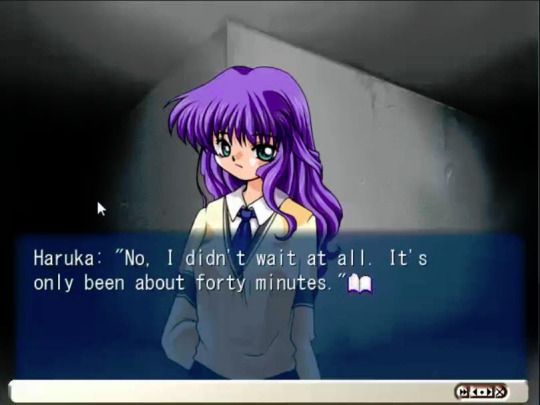
Needless to say, Moon isn’t exactly Clannad. I did not know much about this VN before I got into it, and finding it to be a psychological horror VN was a bit of a shock. Even more of a shock was just what form the majority of the horror came in. You see, even though One ~To the Radiant Season~, Kanon, and Air were all released as adult games, the h-scenes are very disconnected from the plot, most of the time, to the point of losing nothing from skipping them or even removing them from the game, and were pretty much just obligatory inclusions to help them sell better. From Clannad onward, most Key VNs have been clean to start. With Moon, on the other hand, you can’t go 5 minutes without running into some explicit scene, the main source being the Elpod sequences and the abuses the Fargo personnel inflict, and it wastes no time getting to them, at that. This is the biggest thing that drives off many of the few who go out of their way to experience Moon, and even with me having just watched an understandably censored playthrough of this on Youtube due to its shorter length, I almost quit very early into it, and definitely would have if I had actually played it. The Elpod is one thing, as the sequences are used for the purpose of developing Ikumi, but even then, most of them are just excessively disgusting more than disturbing, and that goes doubly for the sequences outside of it. Instead of really changing things up, they’re just content to get gradually more and more depraved, and outside of disgusting, the main thing I can even call them is repetitive. This is one of my biggest problems with Moon, and it was pretty hard for me to get into it because of it.
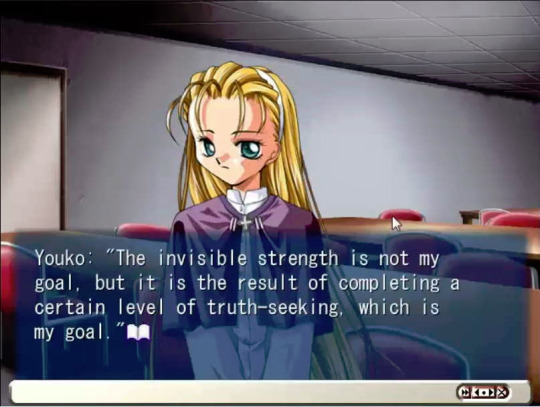
Another major problem I have with Moon is how it handles its cast. Moon is pretty short for a VN, only around 10 or 11 hours if you go straight for the true ending, and even though there are 7 endings in total, they don’t add much more time onto that, with two being worse variants on the true ending, and the rest being bad endings gotten through making bad choices. Having as small a cast as it does should naturally work fine with that, but they really aren’t balanced well. While Ikumi gets developed across the whole game, and Yui gets a good arc pretty early on, Haruka only gets a short arc that ends as quickly as it starts and doesn’t do a lot for her, Youko barely has any screentime despite establishing a good dynamic with Ikumi, and the boy doesn’t have much presence or relevance until late in the story. The pacing is just bizarre and rushed feeling.
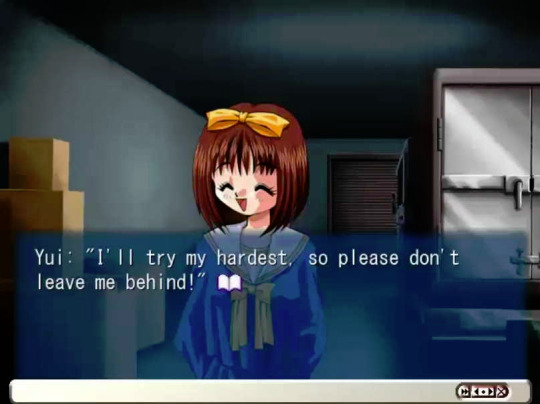
That’s not to say there aren’t a number of good points to Moon’s story. Ikumi is very well developed throughout the story, with the Minmes in particular leading to many melancholic scenes that make her quite sympathetic, and were definitely the high points of the normally rigid daily schedule much of the story takes place during for me. Despite the story’s flawed handling of some of them, the cast is still decent on a whole, with Youko’s gradually developing friendship with Ikumi and Yui’s development during her arc being some of the more memorable parts for me. The atmosphere is very well done, with the cramped, depressing corridors of the facility always feeling like they’re hiding something awful just around the corner, especially since you need to manually navigate the place using a map screen, and once the plot really kicks into high gear things become much more compelling, with the final days containing many high points in characterization and an infamous mindscrew of a sequence that, once looked back on with a more understanding eye, is actually quite fascinating in its own right.
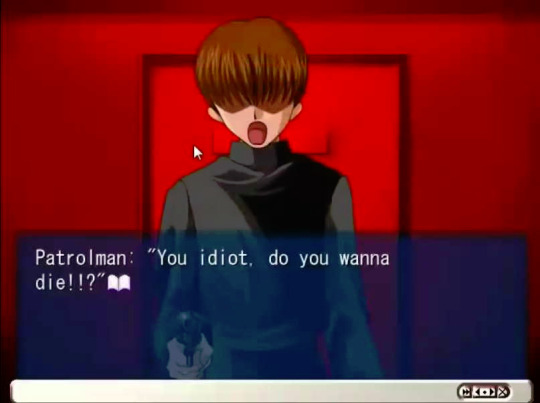
Visually, Moon’s art was done by Itaru Hinoue, the same artist as the majority of Key’s VNs, and it’s a lot rougher than the art of, say, Kanon. It’s not outright bad, but it looks very dated, with the designs and sprites not really sticking out. The CGs vary in quality, as some look pretty ridiculous, but others are quite good. Most impressive, though, is two animated intro sequences included in the DVD version, which happens to be the only version with an English patch anyway. They’re fairly brief, but do a great job of setting up the atmosphere and premise despite that.
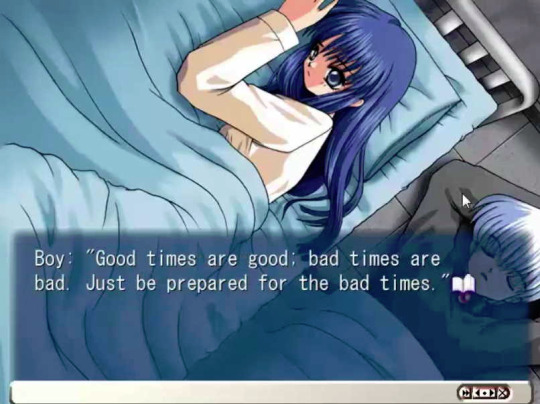
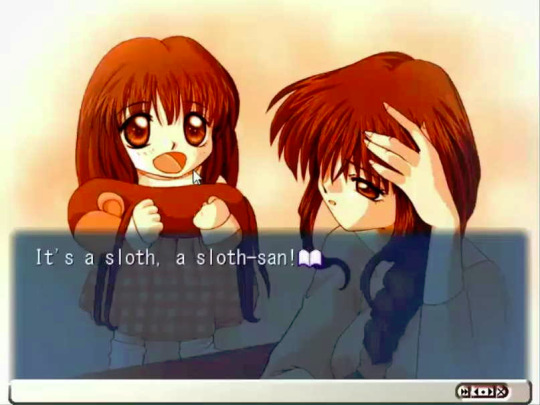

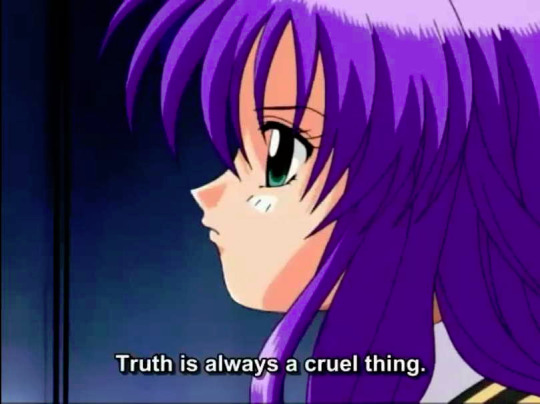
On the sound side, the soundtrack is great. It’s not a very big one, with only about 16 tracks, and the use of them can get a bit repetitive, but most of them are just a joy to listen to. From the electronic and tense Closed Space, to the wistful, yet peaceful The Place Where the Sun Shines, to Youko’s ethereal theme, to the credits theme, Sorrow, and especially the nostalgic music box theme, Memory, it’s worth looking up even if you hold no interest in the VN itself. There’s also voice acting, also added in the DVD version, and most of it is just average, with not many performances standing out, with the exception of Kahoru Sasajima as Ikumi, who delivers a very solid performance, especially during the more intense moments.
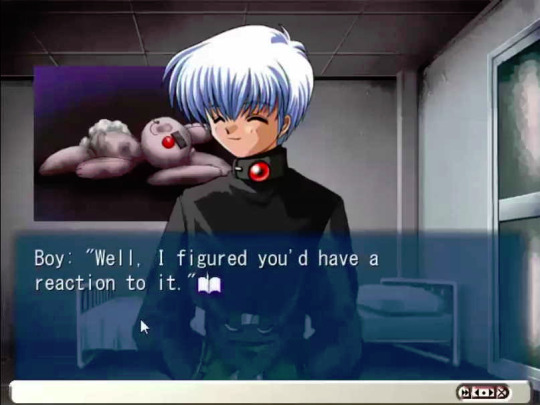
Overall, Moon can be a pretty hard sell. While I thought it was a decent experience by the end, its very offputting content, lack of similarity to any other Key works, and bleak atmosphere can make it pretty hard to go through even if you’re prepared for what’s to come. Even if you wanted a horror VN, there’s plenty others out there, like Chaos;Head and Chaos;Child, Higurashi: When They Cry, Wonderful Everyday, Raging Loop, or just about anything from nitro+. That said, if you can stick to the end, I definitely feel it becomes fairly satisfying, and when I got to thinking, I realized something that actually boosted my opinion quite a bit just by itself. As much as Moon is a story about cults and psychic powers with a somewhat unclear point to it all, it’s even more so just a story about a very troubled youth struggling with her grief, irrationally falling in with a bad crowd, and being forced to face her past and actions if she wishes to accomplish anything. Looking at the story that way, it’s actually quite well done, and going in with that in mind may even make it a bit more palatable. Still, I wouldn’t especially go out of my way to recommend it, and ultimately it’s still very far from being one of my favorite visual novels out there. Either way, that concludes my first mini review, which still turned out longer than I thought it would. My next post will be something unusual for me as well, but that’ll take a bit to come. Till next time.
-Scout
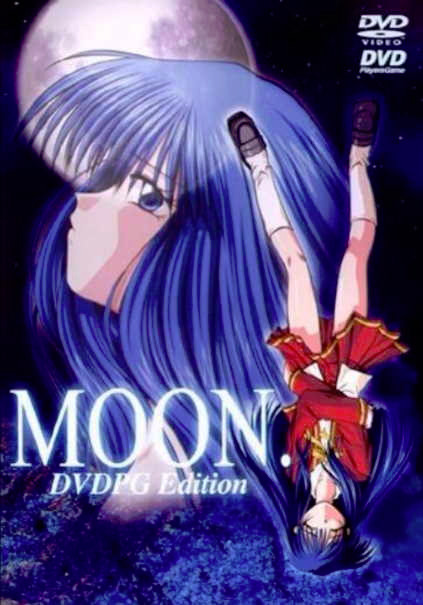
13 notes
·
View notes
Text
[REVIEW] Corpse Party: Blood Drive - The Finality
Makoto Kendouin has returned with yet another sequel of the Corpse Party series. The sequel known as Corpse Party: Blood Drive serves as the concluding tale of the Heavenly Host saga. New characters, new enemies, and a whole new Heavenly Host Elementary School await the unfortunate souls.
The game now comes with a full 3D rendered characters and environment, as well as new 2D sprites. New mechanics have been introduced which isn’t found in the previous games. Some mechanics also returned to full enhance the player experience.
Corpse Party: Blood Drive follows the story from Book of Shadows’ final chapter (it is highly recommended to play the first two games). Ayumi Shinozaki, stricken with grief and guilt at the loss of her dear friends and her sister, seeks out a way to revive her fallen friends. Armed with the Book of Shadows she found in the Shinozaki estate, Ayumi sets out on a journey to redeem herself and undo everything she’s done. But little did she know, a new curse is rapidly growing within the walls of Heavenly Host.
I tried to be as vague as possible with the synopsis to not spoil the story of the entire game to you. If you have no idea on the story of Corpse Party, I highly suggest you play at least the first game. Blood Drive is not an entry-game for players who are new to the series to pick up.
Story
The game is composed of 10 main chapters as well as 8 extra chapters. This is an upgrade from the previous games who only sort 5 and 8 main chapters respectively. Each chapter will give the players the ability to control certain characters and navigate their way into the halls of Heavenly Host. Ayumi is stricken with guilt at being responsible for the death of her friends: Suzumoto Mayu, Sakurato Morishige, Shishido Yui, and Shinohara Seiko, who all died during the events of the first game. It is said that those who died in Heavenly Host, their existence in the real world will be wiped out. It means that no one would be able to remember them except for the survivors.

New characters were introduced in Blood Drive. While they “may” be new to the main games, most of them have appeared in a spin-off game called Corpse Party: Anthology~ Sachiko’s Hysteric Birthday 2U.
Some of these new characters include Niwa Aiko, an intelligence agent and a student of the Paulownia Academy. As one of the characters who accompanied Ayumi in her journey, she is a cheerful person whose real intention is to extort information with the people around her. Her sister, Niwa Kuon, served as the homeroom teacher for Ayumi’s class into the game.

Another one would be Magari Mizuki, a transfer student from the Paulownia Academy. A girl who’s a part of an occult and has vast knowledge of the Book of Shadows. She helped Ayumi traverse the halls of the school in search for a way to revive her fallen friends.

The game also now sports a new antagonist under the name of Sachi. Sachi roams the halls of Heavenly Host. She poses a grave threat to those unfortunate souls who traverse the halls of the school.
It is also said that Blood Drive a lot of references from the other Corpse Party Media. It references heavily from the first two games, Corpse Party Cemetery0, and the anime OVA, Corpse Party Tortured Souls. If you have any idea on what the story of the mentioned media is, then I do hope you’d immediately get the reference after encountering them in the game.
I’d probably talk more about my insights of the story later in this post.
Gameplay
The gameplay vastly improved compared to the first two games. After the backlash that was Book of Shadows, the devs listened to the cries of fans and reverted back to an adventure-type of game. With the enhanced technology of the Playstation Vita, it gave Team GrisGris, the company responsible for the series, new abilities and mechanics that they can incorporate into the game.
Puzzle-solving has returned from the first game. Players get to solve the puzzle behind the story to unlock new areas, new CGs, and progress into the story. The puzzles have been fairly difficult compared to Blood Covered. Each action of the player will have its consequence whether it is good or bad.

The flashlight mechanic has been introduced to the player in this game. Players can use it in order to navigate the school safely. It comes with battery lifespan so players need to scavenge around for batteries to keep the light going. Upon the fans’ requests, the devs also placed in an “endless battery mode”.
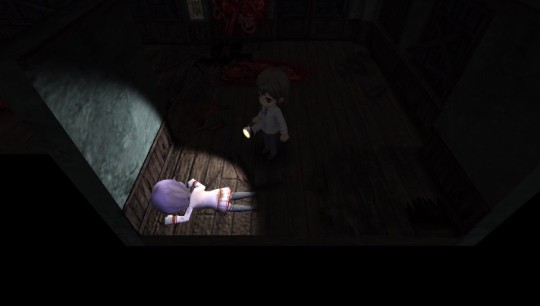
Characters can now move diagonally into the world. This is really helpful when dodging traps, enemies, and other entities inside the school. Phantoms are also incorporated into the game to chase you around the school until you have successfully hid from them or purify them with talismans. This posed a problem because the game lags EVERY TIME a phantom appears. This kinda ruins the overall player experience for lagging on a console. Plus, they can be pretty annoying because they follow you wherever you go.
Graphics
The graphics of this game have improved. Gone were the days of pixel sprites and now comes the age of 3D models in the series. Blood Drive is the second game of the series to ever support 3D models (first being 2013 Corpse Party 2: Dead Patient). While the upgrade from pixel-art to 3D models is good, I think it doesn’t seem to fit well with the overall theme of the game. They looked cute but they’re supposed to be running for their lives, right?

The CGs returned to facilitate better experience for players upon reaching crucial parts of the story. I want to note also that the game is very very brutal. They took the liberty of not putting up CGs or torturing the character models for the sake of narrative execution of the story. This can be their way of “censoring” brutal moments that may deem unfit for their target audience.
Audio
The audio of the franchise is something that I really really enjoyed hearing. Each has been recorded and cued to play at important moments in order to provide the overall atmospheric feel of the current situation in the game. Even if the game doesn’t provide a CGI on some of the brutal murders, you couldn’t help but cringe at what the character is going through with the use of carefully executed sound effects.
The BGM feels great although for me, it doesn’t seem to sit well with the game. BGM now sports more techno-feel at some parts, unfit for a horror game. Kinda ruins the immersion that I have while playing the game. Unlike in the first two games, where the BGM can subtlely provide context on what’s the next thing that would happen, in Blood Drive, it’s almost impossible to decipher what’s next because of how the BGM is played. This isn’t a bad thing since it keeps players in their toes with what’s happening story-wise.
This time around, there are two opening themes that players can listen to. “In the Rain”, sung by Hara Yumi, is played all throughout the first 6 chapters of the game. I couldn’t help but feel that the song reflects Ayumi’s desire to regain her friends from the curse of the school.
The second opening theme is called “Keshin” (Trans: Incarnation) sung by Ayumi’s voice actress, Imai Asami. The song will start to play from Chapter 7 until the final chapter. The song basically reflects Ayumi’s determination and resolve after finding out the truth behind Heavenly Host. Knowing the dangers that she has to face, she steeled herself to face them head on and not run away anymore.
Note: The following below will contain MAJOR SPOILERS to the entire Corpse Party series. If you haven’t had any idea about the overall story of the game, turn away NOW.
Overall Insights

Blood Drive is (in my opinion) the scariest game out of the Corpse Party franchise. I was really scared while playing this game. Aside from the darkened view of the hallways, phantoms will start to chase you out of nowhere and I, as a player, really really hate things that chase you around in horror games. I’m fine with jumpscares just not something that will chase me around.
The story for me feels a bit weird. The inclusion of more depth in the occult-theme of the series kinda threw me off-guard. It kinda became a fantastical thing compared with Blood Covered. Though I’d admit, it was this storyline that gave answers to my questions ever since finishing the first two games. But upon clearing the game’s main story, it just popped out a lot of questions from me once more.

I hated Ayumi ever since the first game. Whiny, crybaby, and disregards other people’s feelings, she was the reason why my favourite character in this series is dead. However, in Blood Drive, I can see the toll of the stress from dealing with black magic have an effect with the blue-haired girl. Having lost her friends in the school, her sister in the Shinozaki estate after her meddling with a forbidden spell, with Naomi’s left eye being damaged because of it. She also tried to deal with everything’s that’s happened on her own so that her friends wouldn’t worry. She became desperate. It turns her into someone who’d trust anyone who has knowledge crucial to Heavenly Host. It was because of her willingness to trust anyone at this point that kickstarted the events of the game.
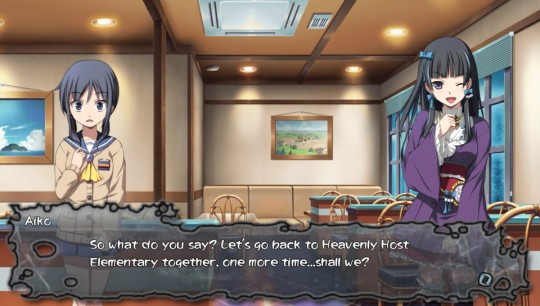
Her friends, the other survivors of the first game, are all worried about their beloved class-rep. So when they learned that Ayumi went back to Heavenly Host alone in order to atone for her wrongdoings, they took it upon themselves to bring her back to the real world. I felt each of the character’s struggle into thinking of coming back to the place where their friends met their demise once more.
I get to see Ayumi, distressed and emotionally unstable, which was used against her. Her distraught made me easily manipulated by some of the characters to do their goal. I think that Blood Drive expounded more on Ayumi’s character development as she comes to terms with what she has done. Her naiveness paved way for her to be more determined and resolved after going through harsh challenges and emotional stress.
So over the course of this game, I slowly started to like Ayumi. Her coming into terms and doing whatever it takes to bring the dead back to life amazes me. It keeps me on my toes on what’s the next thing that would happen. I was also secretly hoping she’ll be able to revive Seiko and the others and have the happy ending that they all so deserve. For the first time in my playthroughs of the games, I hoped that finally, Ayumi’s desires would see the light.

Aside from Ayumi, my fondness of Yoshiki also grew in this game. It is still clear that he truly cares for Ayumi, even to the point of following her blindly into Heavenly Host. The girl used to brush off his antics and concerns but in the course of Blood Drive, the two of them managed to settle their differences...slightly. Ayumi still brushes off Yoshiki at times but acknowledges his presence more over the course of the game.

As for Heavenly Host itself, my first reaction to it is “what the hell happened in here?!” Red patches of blob are scattered all over the school. Tentacle-like tendrils wrap themselves in doors, preventing entry to those who wish to enter. When they say that the school is currently unstable, I was expecting jumbled dimensions and all but not those tentacle...things. It’s disgusting. It doesn’t help that later in the game, the school will once again change its layout, making it even more disgusting! There’s even a poop-shaped thing in the middle of the room!
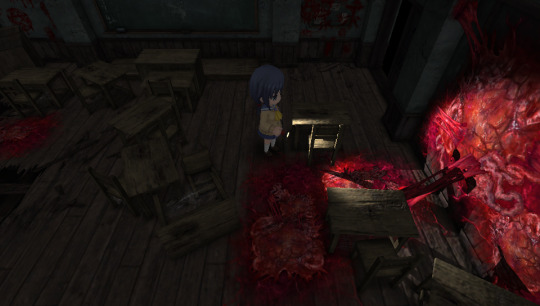

Another thing I really loved about this series is that the game leaves what is happening to your imagination. Certain parts of the game do not have anything going on in them but the descriptive narrative and the audio enhances the story for the player. While this may be their way of censoring “brutal” happenings in the story, it is also a way for players to let their imagination run wild as to what is currently happening to the game. If you have a wild imagination then I hope you’d be able to sleep at night.
The phantoms are the only thing that I really hate with the new Heavenly Host. I tend to suck at the hiding mechanic of the game so I mostly avoid places with phantoms lurking around unless I have a talisman for them. They also made my game lag so much every time they spawn, which incites panic to me. The lag is a result of poor optimization on the developers’ end since it happens 100% of the time.
Speaking of development, there was a game-crashing bug that I encountered in between chapters 3 and 4. Upon reaching a certain part of the game, it will crash. This is a known bug in the Japanese release and the developers made a patch to fix it. But I’m not sure if the patch got carried over to the West when they did their localisation.
All in all, Corpse Party: Blood Drive serves as a sick, twisted, but overall the best way to end the Heavenly Host saga once and for all. The ending of Blood Drive has been referenced in Corpse Party 2: Dead Patient. The game is set 5 years after the events of Blood Drive and for those who have seen or played the game, the introduction of the game finally made sense once you’ve completed Blood Drive. I highly highly recommend this title for anyone who is a fan of the horror genre as well as a fan of the Corpse Party series. Setting aside the technology problems, its well-written story and characters will be enough to keep you up at night.
Make sure to play this at night with your headphones on for a much better and thrilling experience!
#game review#corpse party#corpse party blood drive#ayumi shinozaki#book of shadows#corpse party blood covered
2 notes
·
View notes
Text
Anime Mobile Game Reviews - Yuki Yuna is a Hero: Flower Braid's Sparkle
For some of the 12 Days of Anime Christmas feature on Vanilla♡Blessing, I’ve taken it upon myself to review the magical girl mobile games I wasted actual real hours of my human life playing using a GameFAQs scoring system. - qb
Yuki Yuna wa Yusha de Aru: Han Yui no Kirameki (Yuki Yuna is a Hero: Flower Braid's Sparkle) is a Japanese mobile game released on iOS and Android to promote the new season of Yuki Yuna, a magical girl anime where the girls have severe disabilities and cry a lot. The eponymous heroes fight monsters called the Vertex to protect the great God Tree and Togo is the one with a worryingly nationalist streak and Yuna is the pink one that punches and they’re girlfriends maybe. It’s basically Glitter Force (PreCure) with more crying and depression.

[Yuki Yuna Muscle Wizard art from the mobile game]
“The mobile game takes place inside the godtree, where the Yuushas are tasked with suppressing the rebelling heavenly gods that are inside the godtree (trapped, I guess?) so they don't break out because if they do the godtree will collapse from lack of divine power and take what's left of the human reality with it. Since they're inside the godtree's world, time is meaningless hence why there's yuushas from all eras.” (source)
This is apparently the backstory but I didn't get any of this while playing it because I can't read Japanese. I think they went to the beach once. The story scenes were mandatory and very long and used the Live-2D arm-wavy and mouth flapping tech that actually looks surprisingly fine for how non-intensive it is. It’s pretty much Yuki Yuna Allstars with multiple copies of characters, although it’s slightly confusing that some of the girls are able to walk in cutscenes when their sprites need mechanical assistance. There’s an absolutely massive amount of motion comic story there, with more on the way, but it seems to be mostly pointless fanservice. It also seems to take place after the events of the unaired second season, which further cements its intended audience as the very hardcore fans.
Lore - 6/10
The gameplay can be described as a line-based defense, where you order teams of auto-attacking magical girls to block waves of enemies that flood in from the left side of the screen, and prevent them from reaching the right side of the screen, sometimes ending on a larger enemy as a boss. Through defeating enemies, you can build up meter to spend on special AOE attacks that you slide to activate, typically clearing many enemies at once. Each stage has three missions that can be cleared for additional rewards, and usually require finishing under a strict time limit instead of the normal one, or finishing a stage without having any magical girls knocked out. Like most of these games, Yuki Yuna has a support system where you can hire another player’s magical girl to round out your team.

[Eventually, most of your teams will end up looking like this.]
Unfortunately, due to a combination of design quirks, the higher difficulty stages have time limits that are stricter than the spawn rate of the enemies, making them literally impossible without abuse of the Critical system. In Yuki Yuna, Criticals happen randomly based on your heroes’ CRIT attribute, and in addition to bonus damage, they add two seconds to your decreasing timer for each hit. This means that many of the game’s systems for rock-paper-scissors elemental affinity, or ranged vs melee, or even higher rarity heroes, take a backseat to cramming as many critical hits into your team as humanly possible in order to survive the time limit, rather than the monsters, who you actually want to stay alive for longer. Since only one magical girl in the entire game has a fast attack speed, ranged projectiles, and a good CRIT stat, your team eventually ends up being 3 copies of her. I don’t even know what her name is. Regardless, the gameplay is honestly pretty fun, and can get to blisteringly fast speeds which cuts down significantly on grinding time.
Mechanics - 8/10
Yuki Yuna was very generous with energy, stocking me up with endless energy refreshing items that I never came close to running out of since level up bonuses stacked, resulting in full refills that went well over the maximum amount, even into later levels. I probably could never get through all of the free energy the game throws at you unless I was playing 24 hours a day. The difficulty system of the game was interesting, but was ultimately made difficult by strange design quirks more than higher monster stats, and was sometimes frustrating to play around. Daily Quests were a choke point, with limited time windows in which to complete them on top of separate, limited resources for entry. These extremely limited quests were also the only consistent source of upgrade materials. Leveling materials (always bags of udon) were plentiful, but the upper limit on the highest rarity heroes seemed to go on forever and require infinite amounts of udon. I only saw a couple players that were willing to attempt to grind the tedious and impractical process of maxing out the levels, and I never saw anyone actually get to max level in my entire time with the game. However, the early stages were quick and I never felt like I had to wait to do anything.
Progression - 7/10

[I think these quests were asking me to complete unreleased content, I never figured it out]
Earning new heroes is done through a gacha system that was very generous at the start of the game’s life, with multiple concurrent login bonuses and plenty of one-time premium currency rewards. I was also able, as a free player, to get all the highest rarity cards I wanted with almost no effort. Considering how terrible the game’s paid rates were, it never felt like I was even expected to spend real money. As the game went on, the persistent quests become increasingly impossible and inscrutable, and a majority of the possible progress I could make towards pulling new magical girls ended up coming down to the login bonus rather than anything I could earn through gameplay. However, I never felt any pressure whatsoever to go beyond free-to-play.
Microtransactions - 9/10
By the law of GameFAQs’ perfect review system, Yuki Yuna wa Yusha de Aru: Han Yui no Kirameki (Yuki Yuna is a Hero: Flower Braid's Sparkle) gets a 40/50. It was an odd, fast-paced action game that had some good aspects, but eventually got bogged down in weird design mechanics and I fell off it after it became nearly impossible to progress. Overall though, I had fun, and it was completely free. The other mobile games i’m planning to review were not nearly as nice.
- qb magical girl correspondent
#yuki yuna#Yuki Yuna wa Yusha de Aru: Han Yui no Kirameki#Yuki Yuna is a Hero: Flower Braid's Sparkle#mobile games
5 notes
·
View notes
Text
How to Beat Google’s Mobile Page Speed Benchmarks – Search Engine Journal
Brad Smith
5.5K
READS
Google recently unveiled mobile page speed industry benchmarks and analyzed customer behavior to figure out how the two lined up.
Unfortunately, they didn’t.
Meaning:
Most mobile websites are slooooooooooow.
Consumers won’t wait longer than a few seconds.
That’s a problem. It means the vast majority of mobile websites are losing money, practically forcing customers to bounce and go somewhere else.
Here’s why that’s happening and what you should do about it.
Slow Page Load Speed Sabotages Your Revenue
The probability of someone bouncing from your site increases by 113 percent if it takes seven seconds to load, according to Google’s mobile page speed industry benchmarks, which were released in February.
The problem?
The average time it takes to fully load a mobile landing page is 22 seconds, according to the same report.
That’s not good. In fact, it’s awful because that trickle down effect hits your bottom line, too. Slower sites cause more bounces which then lowers conversions:
“Similarly, as the number of elements—text, titles, images—on a page goes from 400 to 6,000, the probability of conversion drops 95 percent.”
This is nothing new. Slow page speeds have long been public enemy number one for years. Over a decade ago, then-Googler Marissa Mayer confirmed that Google themselves saw a 20 percent drop in traffic with just a 0.5-second delay.
Mobile-first indexation is coming, and speed is the mobile SEO Achilles Heel. E-commerce brands lose half of their traffic if pages take three seconds or longer, which has motivated some to get up-and-running in less than a second.
The primary reason for slow loads? In a word: bloat.
Too much. The way you feel after a Thanksgiving feast.
Google’s latest industry benchmark report analyzed more than 900,000 mobile ads from 126 countries (so sample size apparently ain’t a problem). Seventy percent of pages were over 1MB and “1.49MB takes 7 seconds to load using a fast 3G connection” (which brings things back to seven seconds and the 113 percent increase in likelihood to bounce).
The solution isn’t easy. You’re not gonna like it.
In fact, you might be tempted by a shortcut. It might seem easier initially to use a mobile-friendly alternative like AMP or Facebook Instant Articles.
But that would be a mistake.
Here’s why.
The Problem With AMP & Instant Articles
The Accelerated Mobile Pages Project (AMP) is a self-described “open-source initiative” with the lofty ideal to make the web faster.
Companies who use their technology can see mobile pages load “nearly instantaneously.” It does that by minimizing the amount of resources required through optimizing and compressing notoriously ginormous files like your images.
The ideals are lofty and ambitious. And the results are admittedly good.
Wired Magazine is just one of many huge publishers to reveal glowing highlights, with a 25 percent increase in click-through rates from search results. Gizmodo’s AMP traffic is 80 percent new visitors (presumably coming via search).
Why does AMP perform so well? You don’t need Benedict Cumberbatch for that one. It’s a Google-backed project. So AMP pages tend to get, how should we say, prime mobile SERP placement.
That’s a good thing. But there are a few drawbacks.
AMP is technically more difficult to implement, for starters. Jan Dawson argues that it’s effectively making it harder to publish on the web, writing:
“Technically, these formats use standards-based elements — for example, AMP is a combination of custom HTML, custom JavaScript and caching. But the point here is the outputs from traditional online publishing platforms aren’t compatible with any of these three formats. And in order to publish to these formats directly, you need to know a lot more code than I ever did back in the mid-1990s before the first round of WYSIWYG tools for the web emerged.”
Fortunately, things are slightly easier for WordPress sites. Here’s a three-step guide to setting up AMP on a WordPress site.
There are other problems, though. Losing your branding on AMP pages is one thing. Not good but not a deal killer necessarily. Losing your mobile traffic to Google is quite another, and it’s also the crux of the issue.
AMP content isn’t technically yours anymore. This can impact things like ad revenue, where results are mixed, as seen in the following tweets from Marie Haynes that caught my eye a few months back:
Facebook’s Instant Articles work largely the same way as AMP. Similar pros and cons, too.
Pages load on super speed on the plus side, reportedly up to 10x quicker. Early results from Facebook Partners also showed a 70 percent decrease in Instant Article abandonment (with a 20 percent CTR to boot).
But the same proprietary infrastructure problems have caused many media conglomerates to hit the Pause button. According to analysis from NewsWhip and Digiday, several notable companies have pulled back on Facebook Instant Articles in the last year or so:
Boston Globe went from an incredible 100 percent to 0 percent
Business Insider posted 10 percent and now barely posts 2 percent
The New York Times has dropped to 10 percent
The Atlantic went from posting 85 percent to now only around 10 percent
Other early adopters like the BBC News, National Geographic, and The Wall Street Journal are now “barely using the platform”
Now, this isn’t a Chicken Little, “sky is falling” kinda thing. But it is a cause for concern.
Mobile-friendly platforms offer a tremendous shortcut in boosting mobile page speed. However, there are very serious drawbacks, too, like band-aids on broken arms.
A more prudent approach is to roll up your sleeves, take the long view, and fix your site from the ground-up.
Here’s how to do it.
How to Diagnose Slow Mobile Page Speed
Test My Site is the new version of Google’s old PageSpeed tool (complete with the latest and greatest, 2017 OC Housewives-style facelift).
So start there.
Point and click. This page should pop up next.
Just plug in your URL and hit Test Now.
First, you’ll see the Mobile Friendliness score. Then in the middle is the mobile speed score in question.
Ruh roh.
Let’s scroll down a bit to find out more details on that near-failing grade.
Click on that little box to bring up a detailed assessment of where your site is doing well, along with those areas that aren’t doing so well.
Google mercifully goes into the details of which individual elements are causing you the biggest problems.
Here’s another view of this mobile page speed assessment on a mobile device. Because… why not? Everyone loves a good meta joke.
OK. So the result ain’t pretty. That’s fine. Because now we know what to fix.
The next step is to dive into some of these new mobile page speed industry benchmarks and figure out how to increase them.
Buckle up. It’s about to get geeky.
How to Beat 3 Google Mobile Page Speed Benchmarks
1. Reduce Your Average Request Count
Google’s Best Practice: Fewer Than 50
Requests are literal. Someone tries to visit your website and their browser requests information from your server. The data is compiled and sent back.
The more requests, the longer it takes. Reduce the number of requests that need to be sent back-and-forth and you can greatly reduce average page loading times across the board.
First, reduce the number of files that need to be sent. Yoast cites JavaScript, CSS, and images as your three primary problems.
Minifying JavaScript and CSS kills two birds with one stone. It reduces the number of files that need to be sent back-and-forth. It reduces the overall file size, too.
The GIDNetwork will help you run a compression audit.
Gzip will turn website files into zip files for easier transfers.
WP Super Minify is a WordPress plugin that will do a lot of heavy lifting for you.
Otherwise, Yahoo’s YUI Compressor can help tackle both CSS and JavaScript compression.
Contemporary web design is 90 percent image-driven. I just made up that stat. But you get the point. Today’s websites look like hollow shells if you remove the beautiful, retina-ready images that stretch across your screen.
The problem is that images (if not handled properly) will kill loading times. Once again, Yoast recommends using CSS sprites to combine multiple images into one. SpriteMe, for example, will take background images and combine them to decrease the total number of individual images.
Content Delivery Networks (CDNs) can also help you recoup bandwidth and cut down on website requests. They host large image files for you and distribute them across their own global network of servers. MaxCDN and CloudFlare are among the most popular.
Last but certainly not least, reduce redirects you use if possible. Redirects create additional requests. So proceed with caution.
2. Decrease Average Page Weight
Google’s Best Practice: Less Than 500KB
Seventy-eight percent of shoppers want more product images, according to the Omni Channel Retail report from BigCommerce.
The problem, as we just discussed, is that images can cripple page loads. They create more requests for servers. But they put your average page weight on a bulking plan that would make those meathead bodybuilders at your gym rage with envy.
Page size should be less than 500KB according to Google. And yet a single, unoptimized, high-res image already clocks in at around 1 or 2 MB.
You could start by simply cropping the sizes of your images so each is the exact width and height for the space it’s being used. Except, of course, nobody ever does that. Manually. Every single time they upload an image.
So instead, let’s start by compressing the image file itself with something like WP Smush.it. A non-WordPress tool like Compressor.io can also reduce an image by up to 73 percent.
Let’s run a quick scenario:
Average e-commerce website conversions hover around 1-3 percent.
That number can rise as high as 5 percent. (One example, Natomounts, sees 5 percent conversion rates with ~85 percent from mobile!)
We just discovered that shoppers want more product images.
And yet, according to Radware, 45 percent of the top 100 e-commerce sites don’t compress images!
3. Decrease Average Time to First Byte
Google’s Best Practice: Under 1.3 seconds
Time to first byte (TTFB) is a measurement that shows how long a browser has to wait before receiving its first byte of data from the server.
It’s essentially a three-step process:
A visitor sends an HTTP request to your server.
Your server has to figure out how to respond. This includes gathering the data required and organizing it to be sent back.
Assuming all goes well, the request is sent back to the visitor.
TTFB is the time it takes for that complete cycle to finish.
We’ve already covered a few potential roadblocks during this journey. Too many requests, too many redirects, too many junky WordPress plugins, etc. all take its toll. A website visitor’s own network connection and speed also make an impact.
The aforementioned CDNs also help by reducing your server’s workload. They take over the burden of delivering large files so your own server can focus on delivering the rest of your site’s files and content. The best CDNs even go the extra mile. For example, reducing the physical location between the person requesting a file and the server sending it can have a huge impact.
Caching reduces TTFB by helping web browsers store your website data. Best of all, it only takes a simple plugin (like W3 Total Cache) or using a premium web host that will set up caching for you at the server-level (so no additional tools or plugins are needed).
A web host is like your server’s foundation. You can optimize images all you’d like. Use the best CDN on the market. But if you’re using slow shared hosting that splits resources, your site is going to be slow no matter how many tricks or tips or hacks you use.
Last but not least, a little sleight of hand.
Technically, removing JavaScript files from the head section and relocating them lower on an HTML document won’t reduce the overall number of requests or reduce file sizes. But it will help the important stuff — like the words on each page — to load a little quicker.
JavaScript is selfish. It wants to load all of its code before allowing anything else on the page to have a turn. Pushing it further down forces it to wait its turn until after a few images and basic content can pop up first.
Lazy loading is another common technique that won’t load (or display) an image until it’s within view. That way, page content can be loaded first. That’s helpful on long pages with tons of images (like this blog post). WPMU has a list of six lazy-loading WordPress plugins to try out.
Conclusion
Google has helpfully provided a few mobile page speed benchmarks to shoot for based on their in-depth analysis of what customers want. Unfortunately, the vast majority of websites are nowhere close to them.
Slow mobile page speed has been shown to cause users to bounce, which affects where you show up in search results, and ultimately what your website is able to generate in revenue.
Start by reducing the number of requests that happen each time someone visits your site. Then reduce file sizes along with average time to first byte.
It’ll take some heavy lifting. Definitely some dev help. But it’s your only shot at rescuing sub-par performance that’s sabotaging your bottom line.
Image Credits
Featured Image: Templune/Pixabay.com
In-Post Photo: Google.com
In-Post Photo: Facebook.com
Screenshots by Brad Smith. April 2017.
https://www.searchenginejournal.com/mobile-page-speed-benchmarks/194511/
On – 24 Apr, 2017 By Brad Smith
source https://andlocal.org/how-to-beat-googles-mobile-page-speed-benchmarks-search-engine-journal/
from ANDLOCAL http://andlocal.blogspot.com/2017/05/how-to-beat-googles-mobile-page-speed.html
0 notes
Text
How to Beat Google’s Mobile Page Speed Benchmarks – Search Engine Journal
Brad Smith
5.5K
READS
Google recently unveiled mobile page speed industry benchmarks and analyzed customer behavior to figure out how the two lined up.
Unfortunately, they didn’t.
Meaning:
Most mobile websites are slooooooooooow.
Consumers won’t wait longer than a few seconds.
That’s a problem. It means the vast majority of mobile websites are losing money, practically forcing customers to bounce and go somewhere else.
Here’s why that’s happening and what you should do about it.
Slow Page Load Speed Sabotages Your Revenue
The probability of someone bouncing from your site increases by 113 percent if it takes seven seconds to load, according to Google’s mobile page speed industry benchmarks, which were released in February.
The problem?
The average time it takes to fully load a mobile landing page is 22 seconds, according to the same report.
That’s not good. In fact, it’s awful because that trickle down effect hits your bottom line, too. Slower sites cause more bounces which then lowers conversions:
“Similarly, as the number of elements—text, titles, images—on a page goes from 400 to 6,000, the probability of conversion drops 95 percent.”
This is nothing new. Slow page speeds have long been public enemy number one for years. Over a decade ago, then-Googler Marissa Mayer confirmed that Google themselves saw a 20 percent drop in traffic with just a 0.5-second delay.
Mobile-first indexation is coming, and speed is the mobile SEO Achilles Heel. E-commerce brands lose half of their traffic if pages take three seconds or longer, which has motivated some to get up-and-running in less than a second.
The primary reason for slow loads? In a word: bloat.
Too much. The way you feel after a Thanksgiving feast.
Google’s latest industry benchmark report analyzed more than 900,000 mobile ads from 126 countries (so sample size apparently ain’t a problem). Seventy percent of pages were over 1MB and “1.49MB takes 7 seconds to load using a fast 3G connection” (which brings things back to seven seconds and the 113 percent increase in likelihood to bounce).
The solution isn’t easy. You’re not gonna like it.
In fact, you might be tempted by a shortcut. It might seem easier initially to use a mobile-friendly alternative like AMP or Facebook Instant Articles.
But that would be a mistake.
Here’s why.
The Problem With AMP & Instant Articles
The Accelerated Mobile Pages Project (AMP) is a self-described “open-source initiative” with the lofty ideal to make the web faster.
Companies who use their technology can see mobile pages load “nearly instantaneously.” It does that by minimizing the amount of resources required through optimizing and compressing notoriously ginormous files like your images.
The ideals are lofty and ambitious. And the results are admittedly good.
Wired Magazine is just one of many huge publishers to reveal glowing highlights, with a 25 percent increase in click-through rates from search results. Gizmodo’s AMP traffic is 80 percent new visitors (presumably coming via search).
Why does AMP perform so well? You don’t need Benedict Cumberbatch for that one. It’s a Google-backed project. So AMP pages tend to get, how should we say, prime mobile SERP placement.
That’s a good thing. But there are a few drawbacks.
AMP is technically more difficult to implement, for starters. Jan Dawson argues that it’s effectively making it harder to publish on the web, writing:
“Technically, these formats use standards-based elements — for example, AMP is a combination of custom HTML, custom JavaScript and caching. But the point here is the outputs from traditional online publishing platforms aren’t compatible with any of these three formats. And in order to publish to these formats directly, you need to know a lot more code than I ever did back in the mid-1990s before the first round of WYSIWYG tools for the web emerged.”
Fortunately, things are slightly easier for WordPress sites. Here’s a three-step guide to setting up AMP on a WordPress site.
There are other problems, though. Losing your branding on AMP pages is one thing. Not good but not a deal killer necessarily. Losing your mobile traffic to Google is quite another, and it’s also the crux of the issue.
AMP content isn’t technically yours anymore. This can impact things like ad revenue, where results are mixed, as seen in the following tweets from Marie Haynes that caught my eye a few months back:
Facebook’s Instant Articles work largely the same way as AMP. Similar pros and cons, too.
Pages load on super speed on the plus side, reportedly up to 10x quicker. Early results from Facebook Partners also showed a 70 percent decrease in Instant Article abandonment (with a 20 percent CTR to boot).
But the same proprietary infrastructure problems have caused many media conglomerates to hit the Pause button. According to analysis from NewsWhip and Digiday, several notable companies have pulled back on Facebook Instant Articles in the last year or so:
Boston Globe went from an incredible 100 percent to 0 percent
Business Insider posted 10 percent and now barely posts 2 percent
The New York Times has dropped to 10 percent
The Atlantic went from posting 85 percent to now only around 10 percent
Other early adopters like the BBC News, National Geographic, and The Wall Street Journal are now “barely using the platform”
Now, this isn’t a Chicken Little, “sky is falling” kinda thing. But it is a cause for concern.
Mobile-friendly platforms offer a tremendous shortcut in boosting mobile page speed. However, there are very serious drawbacks, too, like band-aids on broken arms.
A more prudent approach is to roll up your sleeves, take the long view, and fix your site from the ground-up.
Here’s how to do it.
How to Diagnose Slow Mobile Page Speed
Test My Site is the new version of Google’s old PageSpeed tool (complete with the latest and greatest, 2017 OC Housewives-style facelift).
So start there.
Point and click. This page should pop up next.
Just plug in your URL and hit Test Now.
First, you’ll see the Mobile Friendliness score. Then in the middle is the mobile speed score in question.
Ruh roh.
Let’s scroll down a bit to find out more details on that near-failing grade.
Click on that little box to bring up a detailed assessment of where your site is doing well, along with those areas that aren’t doing so well.
Google mercifully goes into the details of which individual elements are causing you the biggest problems.
Here’s another view of this mobile page speed assessment on a mobile device. Because… why not? Everyone loves a good meta joke.
OK. So the result ain’t pretty. That’s fine. Because now we know what to fix.
The next step is to dive into some of these new mobile page speed industry benchmarks and figure out how to increase them.
Buckle up. It’s about to get geeky.
How to Beat 3 Google Mobile Page Speed Benchmarks
1. Reduce Your Average Request Count
Google’s Best Practice: Fewer Than 50
Requests are literal. Someone tries to visit your website and their browser requests information from your server. The data is compiled and sent back.
The more requests, the longer it takes. Reduce the number of requests that need to be sent back-and-forth and you can greatly reduce average page loading times across the board.
First, reduce the number of files that need to be sent. Yoast cites JavaScript, CSS, and images as your three primary problems.
Minifying JavaScript and CSS kills two birds with one stone. It reduces the number of files that need to be sent back-and-forth. It reduces the overall file size, too.
The GIDNetwork will help you run a compression audit.
Gzip will turn website files into zip files for easier transfers.
WP Super Minify is a WordPress plugin that will do a lot of heavy lifting for you.
Otherwise, Yahoo’s YUI Compressor can help tackle both CSS and JavaScript compression.
Contemporary web design is 90 percent image-driven. I just made up that stat. But you get the point. Today’s websites look like hollow shells if you remove the beautiful, retina-ready images that stretch across your screen.
The problem is that images (if not handled properly) will kill loading times. Once again, Yoast recommends using CSS sprites to combine multiple images into one. SpriteMe, for example, will take background images and combine them to decrease the total number of individual images.
Content Delivery Networks (CDNs) can also help you recoup bandwidth and cut down on website requests. They host large image files for you and distribute them across their own global network of servers. MaxCDN and CloudFlare are among the most popular.
Last but certainly not least, reduce redirects you use if possible. Redirects create additional requests. So proceed with caution.
2. Decrease Average Page Weight
Google’s Best Practice: Less Than 500KB
Seventy-eight percent of shoppers want more product images, according to the Omni Channel Retail report from BigCommerce.
The problem, as we just discussed, is that images can cripple page loads. They create more requests for servers. But they put your average page weight on a bulking plan that would make those meathead bodybuilders at your gym rage with envy.
Page size should be less than 500KB according to Google. And yet a single, unoptimized, high-res image already clocks in at around 1 or 2 MB.
You could start by simply cropping the sizes of your images so each is the exact width and height for the space it’s being used. Except, of course, nobody ever does that. Manually. Every single time they upload an image.
So instead, let’s start by compressing the image file itself with something like WP Smush.it. A non-WordPress tool like Compressor.io can also reduce an image by up to 73 percent.
Let’s run a quick scenario:
Average e-commerce website conversions hover around 1-3 percent.
That number can rise as high as 5 percent. (One example, Natomounts, sees 5 percent conversion rates with ~85 percent from mobile!)
We just discovered that shoppers want more product images.
And yet, according to Radware, 45 percent of the top 100 e-commerce sites don’t compress images!
3. Decrease Average Time to First Byte
Google’s Best Practice: Under 1.3 seconds
Time to first byte (TTFB) is a measurement that shows how long a browser has to wait before receiving its first byte of data from the server.
It’s essentially a three-step process:
A visitor sends an HTTP request to your server.
Your server has to figure out how to respond. This includes gathering the data required and organizing it to be sent back.
Assuming all goes well, the request is sent back to the visitor.
TTFB is the time it takes for that complete cycle to finish.
We’ve already covered a few potential roadblocks during this journey. Too many requests, too many redirects, too many junky WordPress plugins, etc. all take its toll. A website visitor’s own network connection and speed also make an impact.
The aforementioned CDNs also help by reducing your server’s workload. They take over the burden of delivering large files so your own server can focus on delivering the rest of your site’s files and content. The best CDNs even go the extra mile. For example, reducing the physical location between the person requesting a file and the server sending it can have a huge impact.
Caching reduces TTFB by helping web browsers store your website data. Best of all, it only takes a simple plugin (like W3 Total Cache) or using a premium web host that will set up caching for you at the server-level (so no additional tools or plugins are needed).
A web host is like your server’s foundation. You can optimize images all you’d like. Use the best CDN on the market. But if you’re using slow shared hosting that splits resources, your site is going to be slow no matter how many tricks or tips or hacks you use.
Last but not least, a little sleight of hand.
Technically, removing JavaScript files from the head section and relocating them lower on an HTML document won’t reduce the overall number of requests or reduce file sizes. But it will help the important stuff — like the words on each page — to load a little quicker.
JavaScript is selfish. It wants to load all of its code before allowing anything else on the page to have a turn. Pushing it further down forces it to wait its turn until after a few images and basic content can pop up first.
Lazy loading is another common technique that won’t load (or display) an image until it’s within view. That way, page content can be loaded first. That’s helpful on long pages with tons of images (like this blog post). WPMU has a list of six lazy-loading WordPress plugins to try out.
Conclusion
Google has helpfully provided a few mobile page speed benchmarks to shoot for based on their in-depth analysis of what customers want. Unfortunately, the vast majority of websites are nowhere close to them.
Slow mobile page speed has been shown to cause users to bounce, which affects where you show up in search results, and ultimately what your website is able to generate in revenue.
Start by reducing the number of requests that happen each time someone visits your site. Then reduce file sizes along with average time to first byte.
It’ll take some heavy lifting. Definitely some dev help. But it’s your only shot at rescuing sub-par performance that’s sabotaging your bottom line.
Image Credits
Featured Image: Templune/Pixabay.com
In-Post Photo: Google.com
In-Post Photo: Facebook.com
Screenshots by Brad Smith. April 2017.
https://www.searchenginejournal.com/mobile-page-speed-benchmarks/194511/
On – 24 Apr, 2017 By Brad Smith
from ANDLOCAL SEO Services https://andlocal.org/how-to-beat-googles-mobile-page-speed-benchmarks-search-engine-journal/
from ANDLOCAL https://andlocalorg.tumblr.com/post/160371326886
0 notes
Text
How to Beat Google’s Mobile Page Speed Benchmarks – Search Engine Journal
Brad Smith
5.5K
READS
Google recently unveiled mobile page speed industry benchmarks and analyzed customer behavior to figure out how the two lined up.
Unfortunately, they didn’t.
Meaning:
Most mobile websites are slooooooooooow.
Consumers won’t wait longer than a few seconds.
That’s a problem. It means the vast majority of mobile websites are losing money, practically forcing customers to bounce and go somewhere else.
Here’s why that’s happening and what you should do about it.
Slow Page Load Speed Sabotages Your Revenue
The probability of someone bouncing from your site increases by 113 percent if it takes seven seconds to load, according to Google’s mobile page speed industry benchmarks, which were released in February.
The problem?
The average time it takes to fully load a mobile landing page is 22 seconds, according to the same report.
That’s not good. In fact, it’s awful because that trickle down effect hits your bottom line, too. Slower sites cause more bounces which then lowers conversions:
“Similarly, as the number of elements—text, titles, images—on a page goes from 400 to 6,000, the probability of conversion drops 95 percent.”
This is nothing new. Slow page speeds have long been public enemy number one for years. Over a decade ago, then-Googler Marissa Mayer confirmed that Google themselves saw a 20 percent drop in traffic with just a 0.5-second delay.
Mobile-first indexation is coming, and speed is the mobile SEO Achilles Heel. E-commerce brands lose half of their traffic if pages take three seconds or longer, which has motivated some to get up-and-running in less than a second.
The primary reason for slow loads? In a word: bloat.
Too much. The way you feel after a Thanksgiving feast.
Google’s latest industry benchmark report analyzed more than 900,000 mobile ads from 126 countries (so sample size apparently ain’t a problem). Seventy percent of pages were over 1MB and “1.49MB takes 7 seconds to load using a fast 3G connection” (which brings things back to seven seconds and the 113 percent increase in likelihood to bounce).
The solution isn’t easy. You’re not gonna like it.
In fact, you might be tempted by a shortcut. It might seem easier initially to use a mobile-friendly alternative like AMP or Facebook Instant Articles.
But that would be a mistake.
Here’s why.
The Problem With AMP & Instant Articles
The Accelerated Mobile Pages Project (AMP) is a self-described “open-source initiative” with the lofty ideal to make the web faster.
Companies who use their technology can see mobile pages load “nearly instantaneously.” It does that by minimizing the amount of resources required through optimizing and compressing notoriously ginormous files like your images.
The ideals are lofty and ambitious. And the results are admittedly good.
Wired Magazine is just one of many huge publishers to reveal glowing highlights, with a 25 percent increase in click-through rates from search results. Gizmodo’s AMP traffic is 80 percent new visitors (presumably coming via search).
Why does AMP perform so well? You don’t need Benedict Cumberbatch for that one. It’s a Google-backed project. So AMP pages tend to get, how should we say, prime mobile SERP placement.
That’s a good thing. But there are a few drawbacks.
AMP is technically more difficult to implement, for starters. Jan Dawson argues that it’s effectively making it harder to publish on the web, writing:
“Technically, these formats use standards-based elements — for example, AMP is a combination of custom HTML, custom JavaScript and caching. But the point here is the outputs from traditional online publishing platforms aren’t compatible with any of these three formats. And in order to publish to these formats directly, you need to know a lot more code than I ever did back in the mid-1990s before the first round of WYSIWYG tools for the web emerged.”
Fortunately, things are slightly easier for WordPress sites. Here’s a three-step guide to setting up AMP on a WordPress site.
There are other problems, though. Losing your branding on AMP pages is one thing. Not good but not a deal killer necessarily. Losing your mobile traffic to Google is quite another, and it’s also the crux of the issue.
AMP content isn’t technically yours anymore. This can impact things like ad revenue, where results are mixed, as seen in the following tweets from Marie Haynes that caught my eye a few months back:
Facebook’s Instant Articles work largely the same way as AMP. Similar pros and cons, too.
Pages load on super speed on the plus side, reportedly up to 10x quicker. Early results from Facebook Partners also showed a 70 percent decrease in Instant Article abandonment (with a 20 percent CTR to boot).
But the same proprietary infrastructure problems have caused many media conglomerates to hit the Pause button. According to analysis from NewsWhip and Digiday, several notable companies have pulled back on Facebook Instant Articles in the last year or so:
Boston Globe went from an incredible 100 percent to 0 percent
Business Insider posted 10 percent and now barely posts 2 percent
The New York Times has dropped to 10 percent
The Atlantic went from posting 85 percent to now only around 10 percent
Other early adopters like the BBC News, National Geographic, and The Wall Street Journal are now “barely using the platform”
Now, this isn’t a Chicken Little, “sky is falling” kinda thing. But it is a cause for concern.
Mobile-friendly platforms offer a tremendous shortcut in boosting mobile page speed. However, there are very serious drawbacks, too, like band-aids on broken arms.
A more prudent approach is to roll up your sleeves, take the long view, and fix your site from the ground-up.
Here’s how to do it.
How to Diagnose Slow Mobile Page Speed
Test My Site is the new version of Google’s old PageSpeed tool (complete with the latest and greatest, 2017 OC Housewives-style facelift).
So start there.
Point and click. This page should pop up next.
Just plug in your URL and hit Test Now.
First, you’ll see the Mobile Friendliness score. Then in the middle is the mobile speed score in question.
Ruh roh.
Let’s scroll down a bit to find out more details on that near-failing grade.
Click on that little box to bring up a detailed assessment of where your site is doing well, along with those areas that aren’t doing so well.
Google mercifully goes into the details of which individual elements are causing you the biggest problems.
Here’s another view of this mobile page speed assessment on a mobile device. Because… why not? Everyone loves a good meta joke.
OK. So the result ain’t pretty. That’s fine. Because now we know what to fix.
The next step is to dive into some of these new mobile page speed industry benchmarks and figure out how to increase them.
Buckle up. It’s about to get geeky.
How to Beat 3 Google Mobile Page Speed Benchmarks
1. Reduce Your Average Request Count
Google’s Best Practice: Fewer Than 50
Requests are literal. Someone tries to visit your website and their browser requests information from your server. The data is compiled and sent back.
The more requests, the longer it takes. Reduce the number of requests that need to be sent back-and-forth and you can greatly reduce average page loading times across the board.
First, reduce the number of files that need to be sent. Yoast cites JavaScript, CSS, and images as your three primary problems.
Minifying JavaScript and CSS kills two birds with one stone. It reduces the number of files that need to be sent back-and-forth. It reduces the overall file size, too.
The GIDNetwork will help you run a compression audit.
Gzip will turn website files into zip files for easier transfers.
WP Super Minify is a WordPress plugin that will do a lot of heavy lifting for you.
Otherwise, Yahoo’s YUI Compressor can help tackle both CSS and JavaScript compression.
Contemporary web design is 90 percent image-driven. I just made up that stat. But you get the point. Today’s websites look like hollow shells if you remove the beautiful, retina-ready images that stretch across your screen.
The problem is that images (if not handled properly) will kill loading times. Once again, Yoast recommends using CSS sprites to combine multiple images into one. SpriteMe, for example, will take background images and combine them to decrease the total number of individual images.
Content Delivery Networks (CDNs) can also help you recoup bandwidth and cut down on website requests. They host large image files for you and distribute them across their own global network of servers. MaxCDN and CloudFlare are among the most popular.
Last but certainly not least, reduce redirects you use if possible. Redirects create additional requests. So proceed with caution.
2. Decrease Average Page Weight
Google’s Best Practice: Less Than 500KB
Seventy-eight percent of shoppers want more product images, according to the Omni Channel Retail report from BigCommerce.
The problem, as we just discussed, is that images can cripple page loads. They create more requests for servers. But they put your average page weight on a bulking plan that would make those meathead bodybuilders at your gym rage with envy.
Page size should be less than 500KB according to Google. And yet a single, unoptimized, high-res image already clocks in at around 1 or 2 MB.
You could start by simply cropping the sizes of your images so each is the exact width and height for the space it’s being used. Except, of course, nobody ever does that. Manually. Every single time they upload an image.
So instead, let’s start by compressing the image file itself with something like WP Smush.it. A non-WordPress tool like Compressor.io can also reduce an image by up to 73 percent.
Let’s run a quick scenario:
Average e-commerce website conversions hover around 1-3 percent.
That number can rise as high as 5 percent. (One example, Natomounts, sees 5 percent conversion rates with ~85 percent from mobile!)
We just discovered that shoppers want more product images.
And yet, according to Radware, 45 percent of the top 100 e-commerce sites don’t compress images!
3. Decrease Average Time to First Byte
Google’s Best Practice: Under 1.3 seconds
Time to first byte (TTFB) is a measurement that shows how long a browser has to wait before receiving its first byte of data from the server.
It’s essentially a three-step process:
A visitor sends an HTTP request to your server.
Your server has to figure out how to respond. This includes gathering the data required and organizing it to be sent back.
Assuming all goes well, the request is sent back to the visitor.
TTFB is the time it takes for that complete cycle to finish.
We’ve already covered a few potential roadblocks during this journey. Too many requests, too many redirects, too many junky WordPress plugins, etc. all take its toll. A website visitor’s own network connection and speed also make an impact.
The aforementioned CDNs also help by reducing your server’s workload. They take over the burden of delivering large files so your own server can focus on delivering the rest of your site’s files and content. The best CDNs even go the extra mile. For example, reducing the physical location between the person requesting a file and the server sending it can have a huge impact.
Caching reduces TTFB by helping web browsers store your website data. Best of all, it only takes a simple plugin (like W3 Total Cache) or using a premium web host that will set up caching for you at the server-level (so no additional tools or plugins are needed).
A web host is like your server’s foundation. You can optimize images all you’d like. Use the best CDN on the market. But if you’re using slow shared hosting that splits resources, your site is going to be slow no matter how many tricks or tips or hacks you use.
Last but not least, a little sleight of hand.
Technically, removing JavaScript files from the head section and relocating them lower on an HTML document won’t reduce the overall number of requests or reduce file sizes. But it will help the important stuff — like the words on each page — to load a little quicker.
JavaScript is selfish. It wants to load all of its code before allowing anything else on the page to have a turn. Pushing it further down forces it to wait its turn until after a few images and basic content can pop up first.
Lazy loading is another common technique that won’t load (or display) an image until it’s within view. That way, page content can be loaded first. That’s helpful on long pages with tons of images (like this blog post). WPMU has a list of six lazy-loading WordPress plugins to try out.
Conclusion
Google has helpfully provided a few mobile page speed benchmarks to shoot for based on their in-depth analysis of what customers want. Unfortunately, the vast majority of websites are nowhere close to them.
Slow mobile page speed has been shown to cause users to bounce, which affects where you show up in search results, and ultimately what your website is able to generate in revenue.
Start by reducing the number of requests that happen each time someone visits your site. Then reduce file sizes along with average time to first byte.
It’ll take some heavy lifting. Definitely some dev help. But it’s your only shot at rescuing sub-par performance that’s sabotaging your bottom line.
Image Credits
Featured Image: Templune/Pixabay.com
In-Post Photo: Google.com
In-Post Photo: Facebook.com
Screenshots by Brad Smith. April 2017.
https://www.searchenginejournal.com/mobile-page-speed-benchmarks/194511/
On – 24 Apr, 2017 By Brad Smith
from ANDLOCAL SEO Services https://andlocal.org/how-to-beat-googles-mobile-page-speed-benchmarks-search-engine-journal/
0 notes
Photo

Hi everyone! Yui here ❤️ I’m back from the spa or whatever the hell I was doing~ I know we said we were going back from hiatus today, and that’s true, but before we kick things off like usual I wanted to do something special: a behind the scenes feature where I tell you guys about Friendship... th-the last arc, not the concept.
There are many things I want to talk about, such as the symbolism I tried to include, the controversy, overall message of the arc, and the reason I decided to do this story in the first place. Hopefully giving you this insight from the POV of the writer helps you understand the reason we spent so much time in this arc, instead of thinking “Yui is a hack who resorts to TV tropes when out of ideas”~ well, besides that, at least.
This is gonna get pretty long but I’ll be thankful if you take the time to read it ^^
Without further ado, let’s go to the first episode of DDLitG Behind the Scenes: Some Final Thoughts on Friendship. Check it out under the cut!
What the story is about:
As a quick summary of the story, so we’re all on the same page, “Friendship” is an arc focused on interpersonal relationships, hence the name. Sayori, during some idle time, decides to visit the local library, where she finds Ako [Named “female student” when she’s introduced]. Ako is not like our main cast, as she is not a .chr file, but an .obj one. This means she is merely a single sprite with a line of description (”Female student is at the library. She draws two flowers and a cat”), made by the game to fill the universe and make it feel less emtpy.
Through the warmth of Sayori’s friendship, she learns more about the world and about what having friends is like, which results in her constantly learning more things and becoming a more complex file.
Sadly, Ako develops feelings for her newfound friend, and when she decides to act on them, the tension that had been building up to that point explodes and conflict arises. The situation is resolved when Sayori reasons that if they work together, their friendship will ultimately overcome the despair of the situation.
Interpersonal relationships: that’s the core of the arc. Sayori’s friendship warming up Ako’s heart and changing her life for the better, Ako working through her feelings towards Sayori so they can remain together, Monika’s and Sayori’s relationship being put to the test with Ako’s arrival. The solution to the conundrum? Trust. Effort. Friendship.
The arc’s messages:
I am of the belief that most fiction carries a message. Most of it, obviously, not all of it. I don’t read Pop Team Epic expecting to learn about the meaning of love... or do I???
Anyway, I always try to put some message that can be extrapolated from the fantastical situations happening and applied to the real world. There are 3 messages I did my best to convey during Friendship. The first one applies to the arc, and the last two are things I’ve been trying to say during most of the story.
1. A friend confessing non-reciprocated feelings does not have to mean the end of your friendship.
Whenever I see the “this person got confessed to while in a relationship�� story in media, the conclusion is always the same: don’t give in to the temptation, your romantic relationship is the more important one, discard the person who confessed from your life.
But what if the person who confessed is an extremely important person to you? What if in cutting them from your life you’ll end up causing more harm than good? Is it possible to continue being friends after rejecting them? Wouldn’t that be awkward?
I don’t want to generalize here. I know we all go through different paths in life, so being all like “this is THE solution to your problem!!” is obnoxious. But I do want to give hope to people who might be going through this situation and don’t wish to end the relationship. Especially those who might be shamed for “friendzoning” the other person.
Again, I’m not saying this is the one and only solution: sometimes cutting ties is the best for both of you. But sometimes, putting the extra effort to work through it together can prove more fruitful and rewarding. Yes, it may be awkward and weird at first, but remember: unreciprocated love eventually fades away, and friendship isn’t a step below or above love.
Even if what I’m saying doesn’t apply to all walks of life, you never know, maybe someone needed to hear that.
During the duration of the arc I was flooded with people asking me to take the chance to make it a Poly relationship. Surely enough, it would’ve been a fantastic opportunity to show a healthy poly relationship, everyone would’ve been fantastically happy at the end, and the “love triangle” trope has been done to death about a thousand times even though that’s the most obvious answer. To those people I want to say: You are so valid, and I love you all. But I wanted to stick to the message of “Friendship overcoming unrequited love”. Something that’s neither “I hate you, go away from my life”, nor “I love you, be my girlfriend”. Something more in-between. Something more like the stage of transition between friendship and love. You know, sort of like... a twilight.
I’ll get to why I wanted to convey this message in specific later in the post. This point has gotten long enough already, so I’ll move on to the next one.
2. The fact that bad things that are not your fault will happen to you is inevitable.
While we grow up, we learn a very simple and crucial part of life: your bad actions will have consequences. If you take cookies without permission, you’ll get scolded. If you spend your whole weekend playing video games instead of studying for a Monday test, you’ll get a bad mark. If you betray a friend, they will not trust you anymore.
From this we usually extrapolate that the reason bad things happen to us is because we made mistakes. And sure enough, that is true most of the time. However, as we grow older, we learn a secondary, less fair fact: sometimes bad things will happen to you, for completely unrelated reasons. And this is inevitable.
There was a very big moral debate during the most tense parts of the arc about which of the 3 protagonists was at fault for the events unfolding. Was it Sayori, for teasing Ako? Was it Monika, for making Sayori feel guilty about hanging out with Ako, and thus made her subconsciously try to seduce her? Was it Ako, for trying to break Sayori’s and Ako’s relationship.
I’m going to write the answer in bold because it’s important: none of the girls were at fault. They were all victims of a bad situation that was not their fault, and due to the stress of it all, ended up committing mistakes.
Sayori was put under a lot of stress due to Monika’s initial disapproval of her relationship with Ako, and even more due to her suspicions that her friend had fallen for her. She was not at fault for Monika’s attitude, nor was she at fault for Ako falling in love with her. Because of this, she committed the mistake of ignoring the problem and try to act as if it were not real.
Monika, due to her previous trauma and lack of self-esteem, immediately feared Sayori was going to abandon her for this new girl she met. Because of her fears, she subconsciously ended making her relationship with Sayori more stressful. Even worse, her suspicions that Ako was in love with her girlfriend were proven right. Monika is not at fault for her trauma or her triggers, and even though she did her best to support her girlfriend, the situation spiraled for the worse and she ended up seeing Sayori suffer, and there was nothing she could do. Because of this, she committed the mistake of becoming aggressive and making it even worse, which ended up translating as physical aggression towards Ako.
Ako went from being a girl with almost no personality to having her life being given a new meaning thanks to Sayori, which regrettably, ended up making her fall in love for Sayori. She was not at fault for her feelings, nor was she at fault for Sayori’s constant subconscious teasing. Because of this, she committed the mistake of acting up on her feelings, going as far as to flirt with Sayori in front of Monika.
The three main characters suffered from situations that were not their fault, and ended up making mistakes due to the high levels of stress they were being exposed to. In real life, this is very common, which is why at the end of every arc I try to give the same message...
3. Even if life is messy and awful things happen for no reason, the possibility of things getting better is always there.
No matter how ugly things get, or how bad the mistakes you make may be, there is always a solution. There is always something that comes after. There is always the possibility to get a happy ending.
Monika learnt from this experience to trust Sayori and herself more, and that aggression does not solve deep emotional problems. Ako learned that she should not have been as confident as she was with her feelings, much less try to hit on Sayori based on her assumptions. Sayori learned that running away from problems does not magically make them go away, and in fact, can make them worse.
Things got ugly. The situation got awful and uncomfortable. People who did not deserve it suffered. Stress caused them to commit atrocious mistakes that made it all worse.
But they made it out ok.
They worked hard, learned from the situation, grew from the experience, and made it out ok.
And so can you.
Why did I decide to write an arc about this?
Both when I mentioned I wanted to add a new character, and when I introduced the love-triangle plot point, people came to the same conclusion: Yui is doing this because she ran out of ideas.
I assure you, that’s not the reason I wrote Friendship. The reason I wrote Friendship is because this situation happened to me.
Some time ago I met the person who would eventually come to be my best friend. A wonderful, amazing person with whom I quickly formed a beautiful relationship. It’s been years since I’ve had a friendship as meaningful as this one, so I wanted to protect it. Then, some months after we met, they confessed they were in love with me.
These were not good news. I was, and still am, in a committed and healthy monogamous relationship. I would not break my girlfriend’s heart by cheating on her, so the only possible option seemed to be break my best friend’s heart by rejecting them, which sadly, I had to resort to.
However, I did not want to cut ties with this person. The relationship we had was extremely important for both of us, and to stop all communication would end up causing more harm to our emotional well-being than good. What could we do?
We decided to stay friends, but to work together to help my friend overcome their unrequited love. To this day, we’re still best friends with each other. It has not been easy, especially for them, but mutual support and understanding goes a long way.
This was a very important and impactful moment in my life. I had something beautiful and hopeful about friendship, and I wanted to express my feelings the same way I always do: by writing in DDLitG about it.
You may not know this, but 99% of the posts in this blog are based on personal experiences. If a day I learn that there’s no reason to hold a standard for myself with my girlfriend, because she loves me and accepts me the way I am, I write about it. If I learn that helping others helps me deal with my own feelings of depression, such as dysphoria, I write about it. If I learn that a particular food or activity can have an emotional value over its own perceived one, I write about it.
After what happened, I really wanted to write about what I had learned. However, I couldn’t write about someone confessing to a character in a relationship, because all four protagonists were already dating. And there’s no way in all of hell that I’m making Natsuki cheat on Yuri to hit on Sayori, that’s downright offensive. Which is why I was like “Hey everyone, I have this idea I want to write about, but I can’t if I don’t introduce another character, so are you ok with that?”
This is why it couldn’t end in a poly either, as good of an idea as it was: I wanted to send a message based on what I learned with my own personal experiences. To betray that would feel like betraying myself. I’m sorry if that explanation doesn’t seem satisfactory for you, but it’s the truth ^^;;
That’s about all I wanted to say ❤️ I know I said I would explain Ako’s name, but I’m afraid this is far too long already, so I’m going to write a separate DDLitG Behind the Scenes chapter titled “What’s The Deal With Ako?”, where I explain her name, why she’s monochromatic, and the overall inspiration for the character, in case you’re interested~ ❤️
If you made it all the way here thank you SO much for reading. I know I wrote a lot, but it means the world to me that you’re this invested in the story and the messages I’m attempting to convey. I hope you found this enjoyable and that you’re leaving with some new insight regarding the last arc. Now we’re ready to move on with the story, and believe me, I’m very excited to keep this going~
Thank you all for your support!! You are all sensational~
-Yui ❤️
160 notes
·
View notes